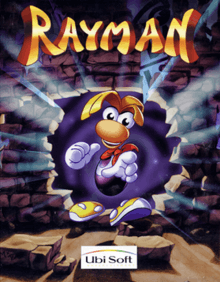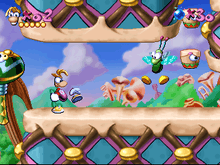Rayman (video game)
| Rayman | |
|---|---|
 | |
| Developer(s) |
|
| Publisher(s) | Ubi Soft |
| Producer(s) | Gérard Guillemot |
| Designer(s) |
|
| Programmer(s) |
|
| Artist(s) |
|
| Composer(s) |
|
| Series | Rayman |
| Platform(s) | Atari Jaguar, PlayStation, Sega Saturn, MS-DOS, Game Boy Color, Game Boy Advance, Nintendo DSi, iOS, Android |
| Release |
1 September 1995
|
| Genre(s) | Platform |
| Mode(s) | Single-player |
Rayman is a side-scrolling platform video game developed by Ubi Pictures and published by Ubi Soft. The first installment in the Rayman series, the game follows the adventures of Rayman, a hero who must save his colourful world from the evil Mr. Dark. Originally designed for the Atari Jaguar in 1995, a PlayStation version was developed and released around the same time (being a North American launch title in the process), and further ports were created for MS-DOS and Sega Saturn in 1996.[1] It has appeared in various other formats, including as Game Boy Advance, PlayStation Network, DSiWare, and iOS and Android devices, of which the latter two versions were removed from digital stores in July 2018.
Gameplay

Rayman is a side-scrolling platform game. The player character is the titular Rayman, who must travel through six worlds (The Dream Forest, Band Land, Blue Mountains, Picture City, The Caves of Skops and Candy Château) to free all of the caged Electoons, six cages of whom are located somewhere on each level. Only when all the Electoons are freed will Rayman be able to reach and confront Mr Dark at his lair in Candy Château. Each level is divided into several maps, each of which is completed when Rayman reaches the "!" sign at the end. The player is given a certain number of lives, which are lost when Rayman takes too many hits or falls into water or a pit. If all lives are lost at any point, the "Game Over" screen will appear, and the player can continue or quit. Scattered around each level are small, sparkling blue spheres called Tings. If the player controlling Rayman picks up 100 (50 in the DSi version), he gains an extra life and the counter resets to zero. When the player loses a life, he loses any Tings he has collected. Tings can also be used to pay the Magician, a character found in certain levels, to enter a bonus stage, where Rayman can win an extra life. Rayman's "telescopic fist", an ability gained early in the game, allows him to punch enemies from a distance; most enemies can be defeated with a certain number of punches. At the end of each world, Rayman must defeat a boss enemy. The player comes across a variety of other power-ups and bonuses, such as a golden fist (which increases punch strength), a speed fist (which increases the speed of Rayman's punches), a power to restore Rayman's lost life energy, and flying blue elves whose touch shrinks Rayman down in size to access new areas.
In early stages of the game, Rayman has the ability to walk, crawl and make silly faces. He obtains additional powers during the game (telescopic punching, holding onto ledges, grappling flying rings, using his hair as helicopter blades to glide, and running) from Betilla the Fairy, while others are given temporarily from his friends that are used for a specific levels only.
Plot
The Great Protoon maintains peace and balance throughout a valley that is Rayman's world. One day, the evil Mr. Dark steals the Great Protoon, leaving the Electoons, small beings who gravitate around it, vulnerable to Mr. Dark's forces, who have captured the Electoons in cages. Rayman must free the Electoons and recover the Great Protoon to restore the valley's balance.[2] Betilla the Fairy, a guardian of the Great Protoon, frequently interacts with Rayman as needed to give him additional magical powers along his journey.
Rayman begins his journey in the Dream Forest, one of the six lands of the valley. He begins with the ability to telescopically punch enemies until Betilla gives him the ability to hang onto ledges. He encounters a kindly local named Tarayzan, who hands over an instantly-sprouting magic seed to help him escape a rising flood. At the end of the Dream Forest, Rayman defeats the first of the game's six bosses, the giant Moskito.[3] Betilla then gives Rayman the power to swing from flying hoops. Rayman arrives in Band Land, a world built around clouds and musical notes, symbols, and instruments. He is chased by Mr. Sax, a giant angry saxophone.[3] Betilla grants Rayman the power to spin his hair like a helicopter for gliding. After defeating Mr. Sax, Rayman progresses through the Blue Mountains, a world of avalanches and rock monsters. He meets the family of musician friend and helps him build a new guitar in exchange for a potion that lets Rayman fly continually using his helicopter hair. Rayman defeats Mr. Stone,[3] and Betilla gives him the ability to run. Picture City, the fourth land, is a world of paintings and art utensils, including slippery ink floors and deadly sharp pencils. Rayman makes his way through to arrive on the stage of a pirate-themed play, where a vicious actress in a Viking costume emerges from the ship's cannon and hurls knives at him. Later, Rayman again encounters this actress who turns out to be the area's boss, Space Mama,[3] in an astronaut costume. Following her defeat, Rayman learns that Mr. Dark has kidnapped Betilla.
Rayman reaches the fifth land, the Caves of Skops, a cave world ruled by Mr. Skops, a giant scorpion. Before he enters he meets Joe, a friendly extraterrestrial, who owns a snack bar whose electric lights have gone out. Joe gives Rayman a firefly to light his way through the cave to reinsert a plug that has fallen out, restoring power to his bar. After crossing a lake and through the caves, Rayman reaches the lair of Mr. Skops and defeats him.[3] After he rescues all of the Electoons, Rayman arrives at the final land, Candy Chateau, made of desserts and crockery. At the end, he faces Mr. Dark[3] who attacks with various disorienting spells. Rayman arrives in the chateau's hall, where Mr. Dark traps him with walls of fire. At the last moment, Electoons retrieve Rayman's ability to punch after Mr. Dark disables it. Upon defeat, Mr. Dark flees, leaving Rayman to face various hybrids of the previous bosses. Upon the defeat of the hybrids, Rayman rescues Betilla and recovers the Great Protoon, thus restoring balance to his world. Rayman then takes a vacation with friends and former enemies.
Development
Conception

The Rayman character came from concepts designed by Michel Ancel, Frédéric Houde, and Alexandra Steible,[4] with Ancel originally drawing Rayman when he was a teenager,[5] influenced by Russian, Chinese and Celtic fairy tales. Ubi Soft funded Ancel's project.
Rayman was initially developed for the Atari ST by Ancel alone.[5] When Frédéric Houde joined the project, they intended to produce a SNES-CD version[5] and the developers hired animators from a cartoon company that considerably improved the graphics; however, the Super NES CD-ROM Adapter was canceled and the SNES version was cancelled in favor of systems with CD support,[6] leaving this version of the game unfinished but playable.[7] A ROM of an early build of the SNES prototype was later released online by Omar Cornut with Ancel's permission on 3 July 2017.[8] The team felt that the Atari Jaguar was the first system that could handle the graphics they wanted and moved development to a Jaguar version,[5] and advertisements in late 1994 announced the game as a Jaguar exclusive.[9] Focus was later shifted to the PlayStation version due to the system's greater power, ease to program for, and CD technology.[5] The Saturn version came later in the development. 32X and 3DO Interactive Multiplayer versions were also announced,[10] but never released.
Reception
| Reception | ||||||||||||||||||||||||
|---|---|---|---|---|---|---|---|---|---|---|---|---|---|---|---|---|---|---|---|---|---|---|---|---|
| ||||||||||||||||||||||||
Rayman has been highly acclaimed for its animated 2D graphics, atmosphere, and soundtrack. It was awarded both "Best Music in a CD-ROM Game" and "Best Animation" in Electronic Gaming Monthly's 1995 Video Game Awards.[23] The game sold 900,000 copies in two years.[24] It is also the best-selling PlayStation game of all time in the United Kingdom, with around 5 million copies sold, beating Tomb Raider II and Gran Turismo in the country.[25] According to Gamasutra, Rayman Advance's sales neared 600,000 units "during the first half of the 2001/2002 fiscal year" alone.[26] The game's sales reached 770,000 copies by the end of March 2002.[27]
Electronic Gaming Monthly gave the PlayStation version a score of 8.625 out of 10 and their "Game of the Month" award. They highly praised the originality, animation, and musical score, and remarked that it firmly disproved the rumor that the PlayStation cannot do side-scrolling games well.[14] GamePro likewise praised the animation and music, as well as Rayman's many acquired abilities, and commented that "Rayman is a dazzling delight and ranks as one of the most visually appealing games of this or any year."[28] A critic for Next Generation, though noting a lack of original gameplay elements, agreed Rayman to be an exceptional game, praising its clever design, depth, graphics, and sound.[18]
Electronic Gaming Monthly gave the Jaguar version an 8 out of 10, assessing that it is an outstanding platformer on its own terms but pales against the PlayStation version due to the lower sound quality of the music and most especially the slow responsiveness of the controls.[15] GamePro also rated it slightly less than the PlayStation version. However, both magazines noted it as one of the best Jaguar games to date, with GamePro remarking "Finally, a game that shows off the Jaguar's capabilities."[29] A critic for Next Generation found the Jaguar version impeccable, venturing that "there is little about the PlayStation or Saturn versions that will top this one."[19]
Sam Hickman of Sega Saturn Magazine gave the Saturn version a 78%, remarking that "if you were just watching somebody else playing the game you could be easily fooled into thinking this was the best thing to appear on the Saturn for quite some time. However, in reality, it's a bit too dull a bit too often, and at times, it's just plain irritating and damned difficult."[21] Japanese reviewers judged the Saturn version similarly, with the game receiving a score a 29 out of 40 by a panel of four reviewers at Famicom Tsūshin.[16] GamePro, however, called it "just what gamers are looking for on the Saturn", and compared it favorably to previous Saturn "hop-n-boppers" Bug! and Astal. They noted that while the graphics and music sometimes seem kiddie-oriented, the challenge is oriented to veteran gamers. They also highly praised the lush visuals and made particular note of the Saturn version's between-level effects.[30]
GameSpot gave the MS-DOS version a 7.4, complaining of several issues such as the infrequent save points, but summarizing, "Take any good scroller like Donkey Kong or Pitfall, add scintillating colors, wonderfully clever gaming elements, engaging and humorous characters, terrific music, and heaps of whimsy and you have Rayman."[17] Next Generation's review praised the graphics, solid game speed even on low-end PCs, "multitude of challenges", and charming player character, and said the game made a good change of pace from other PC releases.[20]
Entertainment Weekly gave the game an A+ and wrote that "Just as Snow White and the Seven Dwarfs was the film that elevated cartoons from lowbrow movie-house fillers to an art form, Rayman may be the title that finally ennobles the adolescent world of videogames. This gentle adventure is so lovingly drawn (the animation recalls Disney in its prime), so perfectly scored (the best game soundtrack I've ever heard), and, most important, so responsive to player control that it makes most other games seem primitive in comparison. (About the only thing pedestrian about it is the plot, in which the cheerful, gangly Rayman sets out to save his fellow 'electoons' from the forces of evil.) If you own a next-generation system, this game is a must-have; if you don't, it might be worth picking up a Saturn or PlayStation just to savor Rayman."[31]
In 2013, Stephen Hill from VentureBeat covered the Playstation version of the game, referring to it as "the most punishing game on the PSone". He remarked that it was very difficult and would guarantee a lot of frustration for modern gamers. He criticized the various factors that contributed to this difficulty, including the punishing save system, the shortage of lives, the abundance of traps, the occasional trial and error level layout and Rayman's limited arsenal in the early game. He also criticized the need to find every cage collectable before being allowed access to the end of the game. However, he praised the game's level design, calling it "genuinely beautiful" and "consistently pretty". Other compliments went towards the graphics and clever use of physics. Hill concludes that the game is made "essentially unplayable" by its high difficulty when played as intended, but that online passwords and cheats make it a decent experience.[32]
References
- ↑ "Wham Bam Rayman". Computer Trade Weekly. No. 556. United Kingdom. 25 September 1995. p. 2.
- ↑ Ubi Soft staff, ed. (1995). Rayman Atari Jaguar instruction manual. Ubi Soft. p. 6. C3669T.
- 1 2 3 4 5 6 Ubi Soft staff, ed. (1995). Rayman Atari Jaguar instruction manual. Ubi Soft. pp. 23–24. C3669T.
- ↑ Ubi Soft staff, ed. (1995). Rayman Atari Jaguar instruction manual. Ubi Soft. p. 31. C3669T.
- 1 2 3 4 5 Retro Gamer Team (4 November 2014). "The Making of Rayman". Retro Gamer. Retrieved 24 October 2016.
- ↑ Pix’N’Love #13
- ↑ Kerr, Chris (24 October 2016). "Michel Ancel unearths Rayman's long-lost SNES debut after 25 years". Gamasutra. Retrieved 24 October 2016.
- ↑ Gach, Ethan. "A Prototype Build Of The Never Completed SNES Rayman Game Is Now On The Internet". Kotaku UK.
- ↑ "Rayman". GamePro (64). IDG. November 1994. p. 185.
- ↑ "Rayman". GamePro. IDG (68): 142. March 1995.
- ↑ "Rayman Advance for Game Boy Advance". GameRankings. CBS Interactive. Retrieved 20 May 2016.
- ↑ "Rayman for Game Boy Color". GameRankings. CBS Interactive. Retrieved 20 May 2016.
- ↑ "Rayman Advance for Game Boy Advance Reviews". Metacritic. CBS Interactive. Retrieved 19 September 2018.
- 1 2 "Review Crew: Rayman". Electronic Gaming Monthly. No. 74. Sendai Publishing. September 1995. p. 34.
- 1 2 "Review Crew: Rayman". Electronic Gaming Monthly. No. 74. Sendai Publishing. September 1995. p. 40.
- 1 2 "New Games Cross Review – RAYMAN". Shūkan Famicom Tsūshin. No.362. Pg.31. 24 November 1995.
- 1 2 Sengstack, Jeff (11 June 1996). "Rayman Review". GameSpot. Retrieved 7 July 2014.
- 1 2 "Rayman". Next Generation. No. 10. Imagine Media. October 1995. p. 110.
- 1 2 "Rayman". Next Generation. No. 11. Imagine Media. November 1995. p. 177.
- 1 2 "Rayman". Next Generation. No. 18. Imagine Media. June 1996. p. 125.
- 1 2 Hickman, Sam (November 1995). "Review: Rayman". Sega Saturn Magazine. Emap International Limited (1): 74–75.
- ↑ Dotson, Carter (18 February 2016). "'Rayman Classic' Review – Let Sleeping Raymen Lie". TouchArcade. Retrieved 19 September 2018.
- ↑ "Electronic Gaming Monthly's Buyer's Guide". 1996.
- ↑ Malaval, Philippe; Bénaroya, Christophe (31 January 2001). Strategy and Management of Industrial Brands. Malaval. pp. 297–8. ISBN 978-0-7923-7970-6. Retrieved 28 December 2009.
- ↑ PlayStation's last hurrah
- ↑ "Acquisitions Propel Ubi Soft Sales Up 72%". Gamasutra. 5 November 2001. Archived from the original on 11 August 2014. Retrieved 2 July 2012.
- ↑ "Consolidated Sales for the 2001/2002 Financial Year: 369 million euros (+42%); Consolidated Sales for the 4th Quarter of 2001/2002 are up by 14%" (Press release). Ubisoft. 2 May 2002. Archived from the original on 21 September 2017.
- ↑ "ProReview: Rayman". GamePro. No. 85. IDG. October 1995. p. 42.
- ↑ "ProReview: Rayman". GamePro. No. 84. IDG. September 1995. p. 64.
- ↑ "Rayman". GamePro. No. 87. IDG. December 1995. p. 76.
- ↑ https://ew.com/article/1995/11/17/rayman/
- ↑ Rayman – The most punishing game on the PSone, VentureBeat